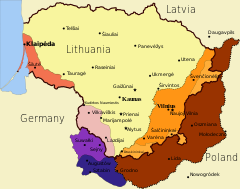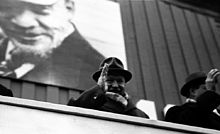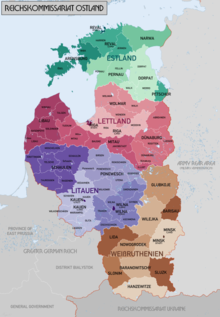German occupation of Lithuania during World War II
This article needs additional citations for verification. (January 2011) |
| Part of a series of articles on the |
| Occupation of the Baltic states |
|---|
 |
The
Background

In August 1939, the Soviet Union and Nazi Germany signed the
Almost immediately after the German–Soviet Boundary and Friendship Treaty, the Soviets pressured the Lithuanians into signing the

Soon after the occupation started, Sovietization policies were implemented. On July 1, all political, cultural, and religious organizations were closed,[11] with only the Communist Party of Lithuania and its youth branch allowed to exist. All banks (including all accounts above 1,000 litas), real estate larger than 170 square metres (1,800 sq ft), private enterprises with more than 20 workers or more than 150,000 litas of gross receipts were nationalized.[12] This disruption in management and operations created a sharp drop in production. Russian soldiers and officials were eager to spend their appreciated rubles and caused massive shortages of goods.[13] To turn small peasants against large landowners, collectivization was not introduced in Lithuania. All land was nationalized, farms were reduced to 30 hectares (74 acres), and extra land (some 575,000 hectares (5,750 km2)) was distributed to small farmers.[14] In preparation for eventual collectivization, new taxes between 30% and 50% of farm production were enacted.[11] The Lithuanian litas was artificially depreciated to 3–4 times its actual value and withdrawn by March 1941.[14] Before the elections to the People's Parliament, the Soviets arrested some 2,000 prominent political activists.[13] These arrests paralyzed any attempts to create anti-Soviet groups. An estimated 12,000 were imprisoned as "enemies of the people."[13] When farmers were unable to meet exorbitant new taxes, some 1,100 of the larger farmers were put on trial.[15] On June 14–18, 1941, less than a week before Germany's invasion, some 17,000 Lithuanians were deported to Siberia, where many perished due to inhumane living conditions (see June deportation).[16][17] Some of the many political prisoners were massacred by the retreating Red Army. These persecutions were key in soliciting support for the Nazis.
German invasion and Lithuanian revolt

On June 22, 1941, the territory of the Lithuanian SSR was invaded by two advancing German army groups: Army Group North, which took over western and northern Lithuania, and Army Group Centre, which took over most of the Vilnius Region. The first attacks were carried out by the Luftwaffe against Lithuanian cities and claimed lives of some 4,000 civilians.[19] Most Russian aircraft were destroyed on the ground. Germans rapidly advanced, encountering only sporadic resistance from the Soviets and help from Lithuanians, who saw them as liberators and hoped that the Germans would re-establish their independence or at least autonomy.[citation needed]
Lithuanians took up arms against the Soviet for independence. Groups of men took control of strategic objects such as railroads, bridges, communication equipment and food warehouses, protecting them from potential
The Battle of Raseiniai began June 23 as Soviets attempted to mount a counterattack, reinforced by tanks, but were overpowered by the 27th.[20] It is estimated that the uprising involved some 16,000[21] to 30,000 people and claimed lives of about 600 Lithuanians[21] and 5,000 Soviet activists. On June 24, Germans entered both Kaunas and Vilnius without a fight.[22] Within a week, the Germans had sustained 3,362 losses, but controlled the entire country.[23]
German occupation
Administration

During the first days of war, German military administration, chiefly concerned with the region's security, tolerated Lithuanian attempts to establish their own administrative institutions and left a number of civilian issues to the Lithuanians. The Provisional Government in Kaunas attempted to establish the proclaimed independence of Lithuania and undo the damage of the one-year Soviet regime. During the six weeks of its existence, the Government issued about 100 laws and decrees, but they were largely not enforced. Its policies can be described as both
The Germans did not recognize the Lithuanian government, and at the end of July formed their own civil administration, part of the
The Holocaust

Before
Unlike in other Nazi-occupied countries where the Holocaust was introduced gradually (first limiting Jewish civil rights, then concentrating Jews in ghettos, and only then executing them in death camps), executions in Lithuania started on the first days of war.
The surviving 43,000 Jews were concentrated in the
The genocide rate of Jews in Lithuania, up to 95–97%, was the highest in Europe. This was primarily due, with few notable exceptions, to widespread Lithuanian cooperation with the German authorities. Jews were widely blamed for the previous Soviet regime (see
Collaboration

Lithuanians formed several units that actively assisted Germans:[32]
- Lithuanian Auxiliary Police Battalions– 26 battalions with 12,000–13,000 men
- Lithuanian Construction Battalions– 5 battalions with 2,500 men
- Lithuanian Territorial Defense Force – 10,000–12,000 men
- Self-Defence units– 3,000 men
- Homeland Protection Detachment– 6,000 men
10 of the Lithuanian police battalions, working with the Nazi Einsatzkommando, were involved in mass killings, and are thought to have executed 78,000 individuals.[26]: 148
Many[vague] members of the Lithuanian construction units were asked to join the Waffen-SS, of whom up to 40% eventually did, although no Lithuanian national unit was ever formed under the Waffen-SS, and all volunteers served on an individual basis.[citation needed]
Resistance

The majority of anti-Nazi resistance in Lithuania came from the
The activities of Soviet partisans in Lithuania were partly coordinated by the Command of the Lithuanian Partisan Movement headed by Antanas Sniečkus and partly by the Central Command of the Partisan Movement of the USSR.[33]
There was no significant violent resistance directed against the Nazis originating from the Lithuanian society. In 1943, several underground political groups united under the Supreme Committee for the Liberation of Lithuania (Vyriausias Lietuvos išlaisvinimo komitetas or VLIK). It became mostly active outside of Lithuania among emigrants and deportees, and was able to establish contacts in Western countries and get support for resistance operations inside Lithuania (see Operation Jungle). It persisted abroad for many years as one of the groups representing Lithuania in exile.[35][36]
In 1943, the Nazis attempted to raise a
Soviet re-occupation, 1944
The Soviet Union reoccupied Lithuania as part of the
Demographic losses
Lithuania suffered significant losses in World War II and the first post-war decade. Historians attempted to quantify population losses and changes, but their task was complicated by the lack of precise and reliable data. There were no censuses taken between the
- victims of the Holocaust
- victims of Soviet repressions
- refugees or repatriates.
| Period | Source | |||
|---|---|---|---|---|
| Vaitiekūnas (2006)[45] |
Truska (2005)[48] |
Damušis (1990)[49] |
Zundė (1964)[47] | |
| First Soviet occupation (June 1940 – June 1941) |
161,000 | 76,000 | 135,600 | 93,200 |
| Nazi occupation (June 1941 – January 1945) |
464,600 | 504,000 | 330,000 | 373,800 |
| ⇨ Murdered during the Holocaust | 200,000 | 200,000 | 165,000 | 170,000 |
| ⇨ War refugees from Klaipėda Region | 150,000 | 140,000 | 120,000 | 105,000 |
| ⇨ War refugees from Lithuania | 60,000 | 64,000 | 60,000 | |
| ⇨ Other | 54,600 | 100,000 | 45,000 | 38,800 |
| Second Soviet occupation (January 1945 – 1953) |
530,000 | 486,000 | 656,800 | 530,000 |
| Total | 1,155,600 | 1,066,000 | 1,122,600 | 997,000 |
References
- Notes
- ^ Skirius (2002)
- ^ Clemens (2001), p. 6
- ^ Eidintas (1999), p. 170
- ^ Eidintas (1999), pp. 172–173
- ^ Gedye, G.E.R. (1939-10-03). "Latvia Gets Delay on Moscow Terms; Lithuania Summoned as Finland Awaits Call to Round Out Baltic 'Peace Bloc'". The New York Times: 1, 6.
- ^ Vardys (1997), p. 47
- ^ Sabaliūnas (1972), pp. 157–158
- ^ Rauch (2006), pp. 219–221
- ^ Vardys (1997), pp. 49–53
- ^ "The face of cruelty". VilNews. 2011.
- ^ a b Kamuntavičius (2001), pp. 408–409
- ^ Anušauskas et al. (2005), pp. 116–117, 119
- ^ a b c Lane (2001), pp. 51–52
- ^ a b Anušauskas et al. (2005), pp. 120–121
- ^ Anušauskas et al. (2005), p. 123
- ^ Anušauskas et al. (2005), p. 140
- ^ Gurjanovas (1997)
- ^ "Killing Jews in the yard of NKVD garage in June 1941 (ex "Lietūkis")". Liutauras Ulevičius.
- ^ Anušauskas et al. (2005), p. 162
- ^ Anušauskas et al. (2005), p. 163
- ^ a b Anušauskas et al. (2005), p. 171
- ^ Anušauskas et al. (2005), p. 165
- ^ Anušauskas et al. (2005), p. 164
- ^ MacQueen (1998)
- ^ Baumel & Laqueur (2001), pp. 51–52
- ^ ISBN 9781780961637.
- ^ Einsatzgruppen Archives Archived 2008-10-26 at the Wayback Machine.
- ^ Porat (2002), p. 161
- ^ a b Bubnys (2004), pp. 216–218
- ^ Senn (Winter 2001)
- ^ Liekis (2002)
- ^ Stoliarovas (2008), pp. 15–16
- ^ Janavičienė (1997)
- About.com. Retrieved 2006-06-29.
- ^ Kaszeta (Fall 1988)
- ^ Banionis (2004)
- ^ Peterson (2001), p. 164
- ^ Lane (2001), p. 57
- ^ Mackevičius (Winter 1986)
- ^ a b Snyder (2003), p. 84
- ^ Muriev (1984), pp. 22–28
- ^ Eidintas (1999), p. 45
- ^ Vaitiekūnas (2006), p. 150
- ^ Anušauskas et al. (2005), p. 395
- ^ a b Vaitiekūnas (2006), p. 143
- ^ Damušis (1990), p. 30
- ^ a b Zundė (1964)
- ^ Anušauskas et al.
(2005), pp. 388–395 - ^ Damušis (1990), pp. 25–26
- Bibliography
- Anušauskas, Arvydas; Bubnys, Arūnas; Kuodytė, Dialia; Jakubčionis, Algirdas; Titinis, Vytautas; Truska, Liudas, eds. (2005). Lietuva, 1940–1990 (in Lithuanian). Vilnius: ISBN 9986-757-65-7.
- Banionis, Juozas (2004). "Lietuvos laisvinimo veikla Vakaruose įsigalint detantui 1970–1974 m." Genocidas Ir Rezistencija (in Lithuanian). 15. ISSN 1392-3463.
- Baumel, Judith Tydor; Laqueur, Walter (2001). "Baltic Countries". The Holocaust Encyclopedia. Yale University Press. ISBN 0-300-08432-3.
- Bubnys, Arūnas (2004). "The Holocaust in Lithuania: An Outline of Major Stages and Their Results". In Nikžentaitis, Alvydas; Schreiner, Stefan; Staliūnas, Darius (eds.). The Vanished World of Lithuanian Jews. Rodopi. ISBN 90-420-0850-4.
- Clemens, Walter C. (2001). The Baltic Transformed: Complexity Theory and European Security. Rowman & Littlefield. ISBN 0-8476-9859-9.
- Damušis, Adolfas (1990). Lietuvos gyventojų aukos ir nuostoliai Antrojo pasaulinio karo ir pokario 1940—1959 metais (in Lithuanian) (2nd ed.).
- Eidintas, Alfonsas; Žalys, Vytautas; Senn, Alfred Erich (1999). Tuskenis, Edvardas (ed.). Lithuania in European Politics: The Years of the First Republic, 1918–1940. New York: St. Martin's Press. ISBN 0-312-22458-3.
- Gurjanovas, Aleksandras (1997). "Gyventojų trėmimo į SSRS gilumą mastas (1941 m. gegužės–birželio mėn.)". Genocidas Ir Resistencija (in Lithuanian). 2. ISSN 1392-3463.
- Janavičienė, Audronė (1997). "Sovietiniai diversantai Lietuvoje (1941–1944)". Genocidas Ir Rezistencija (in Lithuanian). 1. ISSN 1392-3463.
- Kamuntavičius, Rūstis; Kamuntavičienė, Vaida; Civinskas, Remigijus; Antanaitis, Kastytis (2001). Lietuvos istorija 11–12 klasėms (in Lithuanian). Vilnius: Vaga. ISBN 5-415-01502-7.
- Kaszeta, Daniel J. (1988). "Lithuanian Resistance to Foreign Occupation 1940-1952". Lituanus. 3 (34). ISSN 0024-5089.
- Lane, Thomas (2001). Lithuania: Stepping Westward. Routledge. ISBN 0-415-26731-5.
- Liekis, Šarūnas (2002). "Žydai: "kaimynai" ar "svetimieji"? Etninių mažumų problematika". Genocidas Ir Rezistencija (in Lithuanian). 12. ISSN 1392-3463.
- Mackevičius, Mečislovas (Winter 1986). "Lithuanian resistance to German mobilization attempts 1941-1944". ISSN 0024-5089.
- MacQueen, Michael (1998). "The Context of Mass Destruction: Agents and Prerequisites of the Holocaust in Lithuania" (PDF). Holocaust and Genocide Studies. 12 (1): 27–48. .
- Muriyev, Dado (1984). "Preparations, Conduct of 1944 Baltic Operation Described". Military History Journal. 9. Joint Publications Research Service.[dead link]
- Peterson, Roger D. (2001). Resistance and Rebellion: Lessons from Eastern Europe. Cambridge University Press. ISBN 0-521-77000-9.
- Porat, Dina (2002). "The Holocaust in Lithuania: Some Unique Aspects". In Cesarani, David (ed.). The Final Solution: Origins and Implementation. Routledge. ISBN 0-415-15232-1.
- Rauch, Georg von (2006). The Baltic States: The Years of Independence 1917–1940. London: Hurst & Company. ISBN 1-85065-233-3.
- Sabaliūnas, Leonas (1972). Lithuania in Crisis: Nationalism to Communism 1939–1940. Indiana University Press. ISBN 0-253-33600-7.
- Senn, Alfred E. (Winter 2001). "Reflections on the Holocaust in Lithuania: A New Book by Alfonsas Eidintas". Lituanus. 4 (47). ISSN 0024-5089.
- Skirius, Juozas (2002). "Klaipėdos krašto aneksija 1939–1940 m.". Gimtoji istorija. Nuo 7 iki 12 klasės (in Lithuanian). Vilnius: Elektroninės leidybos namai. ISBN 9986-9216-9-4. Retrieved 2008-03-14.
- Stoliarovas, Andriejus (2008). Lietuvių pagalbinės policijos (apsaugos) 12-asis batalionas (Thesis) (in Lithuanian). Vytautas Magnus University.
- ISBN 0-300-10586-X.
- Vaitiekūnas, Stasys (2006). Lietuvos gyventojai: Per du tūkstantmečius (in Lithuanian). Vilnius: Mokslo ir enciklopedijų leidybos institutas. ISBN 5-420-01585-4.
- Vardys, Vytas Stanley; Sedaitis, Judith B. (1997). Lithuania: The Rebel Nation. Westview Series on the Post-Soviet Republics. WestviewPress. ISBN 0-8133-1839-4.
- Zundė, Pranas (1964). "Lietuvos gyventojų dinamika ir struktūra". ISSN 0002-208X.
- Secondary sources believed to meet Eastern Europe criteria
- Sužiedelis, Saulius (2006). "Lithuanian Collaboration during the Second World War: Past Realities, Present Perceptions: Collaboration and Resistance during the Holocaust: Belarus, Estonia, Latvia, Lithuania". The Mass Persecution and Murder of Jews: The Summer and Fall of. Vol. 158.2004. University of California Press. pp. 313–359. ISBN 978-0-520-02600-1.
This presentation is in part a modified summary and collation of my studies presented in earlier venues: *;My reports **Foreign Saviors, Native Disciples: Perspectives on Collaboration in Lithuania, 1940–1945, presented in April 2002 at the "Reichskommissariat Ostland" conference at Uppsala University and Södertörn University College, now published in: Collaboration and Resistance during the Holocaust. Belarus, Estonia, Latvia, Lithuania, ed. David Gaunt et al *;My articles in Vilnius at the conference Holocaust in Lithuania in Vilnius 2002: **The Burden of 1941, in: 'Lituanus' 47:4 (2001), pp. 47-60; **Thoughts on Lithuania's Shadows of the Past: A Historical Essay on the Legacy of War, Part I, in: 'Vilnius (Summer 1998), pp. 129-146; **Thoughts on Lithuania's Shadows of the Past: A Historical Essay on the Legacy of War, Part II, in: 'Vilnius' (Summer 1999), pp. 177-208...
- Piotrowski, Tadeusz (2007). Poland's Holocaust: Ethnic Strife, Collaboration with Occupying Forces and Genocide in the Second Republic, 1918-1947 (illustrated ed.). McFarland. ISBN 978-0786429134. ** despite the title, this source contains several substantive mentions of Lithuania's circumstances. While Lithuania is not its primary topic, the histories of the two countries are closely interrelated and the mentions are well beyond passing references; several are three or more pages long
- Full text available online
- Dov Levin (2000). The Litvaks: A Short History of the Jews in Lithuania - Berghahn Series (illustrated ed.). Berghahn Books. p. 283. ISBN 9653080849.
- Dov Levin (2000). The Litvaks: A Short History of the Jews in Lithuania - Berghahn Series (illustrated ed.). Berghahn Books. p. 283.
- Gruodyte, Edita; Adomaityte, Aurelija. "The Tragedy of the Holocaust in Lithuania: From the Roots of the Identity to the Efforts towards Reconciliation" (PDF). repozytorium.uni.pl.
Criterion problems
- Sužiedelis, Saulius. "341. The Perception of the Holocaust: Public Challenges and Experience in Lithuania". Wilson Center.
- I believe the Wilson Center is considered "a reputable institution" if not though, this may well qualify as written by an expert
- June 1999 United States Justice Department
- I believe the US Justice Department is considered "a reputable institution" if not though, this may well qualify as written by an expert since afaik it concerns their litigation
- Malinauskaite. "Holocaust Memory and Antisemitism in Lithuania: Reversed Memories of the Second World War" (PDF).
- Malinauskaitė, Gintarė (2019). Mediated Memories: Narratives and Iconographies of the Holocaust in Lithuania. Marburg.
{{cite book}}: CS1 maint: location missing publisher (link) - Sužiedėlis, Saulius (2006). "Lithuanian Collaboration during the Second World War: Past Realities, Present Perceptions". In Tauber, Joachim (ed.). "Kollaboration" in Nordosteuropa: Erscheinungsformen und Deutungen im 20. Jahrhundert (PDF). Wiesbaden.
{{cite book}}: CS1 maint: location missing publisher (link) - Sužiedėlis, Simas, ed. (1970–1978). "Juozas Brazaitis". LCCN 74-114275.
- Wnuk, Rafał (2018). Leśni bracia. Podziemie antykomunistyczne na Litwie, Łotwie i w Estonii 1944-1956 [Forest Brothers. Anti-communist underground in Lithuania, Latvia and Estonia 1944-1956] (in Polish). Lublin.
{{cite book}}: CS1 maint: location missing publisher (link) - Woolfson, Shivaun (2014). Holocaust Legacy in Post-Soviet Lithuania. People, Places and Objects. Bloomsbury Academic.
- Vareikis, Vygantas (2009). "In the Shadow of the Holocaust: Lithuanian-Jewish Relations in the Crucial Years 1940-1944". In Bankier, David; Gutman, Israel (eds.). Nazi Europe and the Final Solution. ISBN 978-1-84545-410-4.
- Veilentienė, Audronė (2016). "Vytauto Didžiojo universitetas nacių okupacijos metais ir antinacinė rezistencija" [Vytautas Magnus University during the Nazi Occupation and Anti-Nazi Resistance]. Kauno istorijos metraštis. 16: 195–217. .
